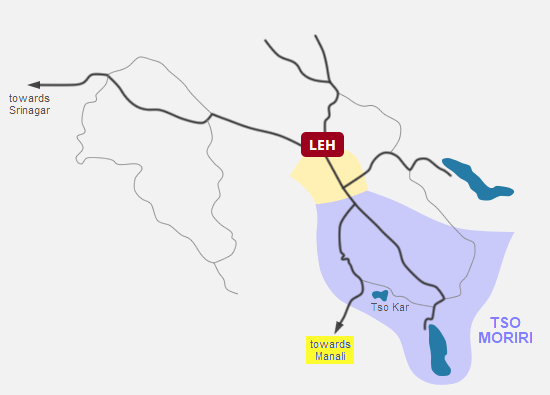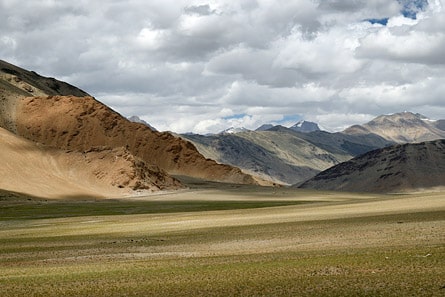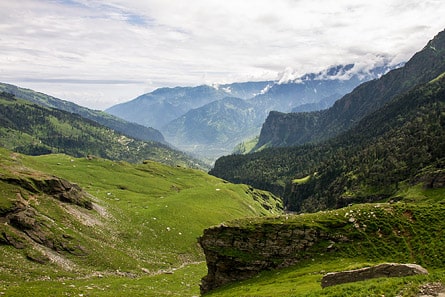

The road trip from Leh to Manali takes two days via Pang, Sarchu and Jispa. It is one of the most spectacular road trips in the Himalaya, crossing numerous high mountain passes including the famous Taglang La pass and Rohtang La pass.
With one or two extra days, you could extend the road trip to the magnificent Tso Moriri lake. You will drive via Chumathang hot springs to reach Korzok village on the shore of Tso Moriri lake. Next, you will discover Puga hot springs and Tso Kar lake where you may be able to see the majestic black-necked crane before joining the Leh-Manali highway towards Manali.
You can choose whether you want to include Tso Moriri lake in your Leh to Manali road trip:
If you are interested in a great road trip which includes Nubra valley, Pangong lake, Tso Moriri lake and ends in Manali, check out this tour.


The journey from Leh to Manali is a breathtaking road trip through the Himalaya. The remote road goes through scenic landscapes and some of the world's highest mountain passes. If you have an extra day, it is worth doing a side trip to Tso Moriri lake and Tso Kar lake, some of the most amazing natural sites of Ladakh.

The Leh-Manali highway is a 470 km long adventurous road connecting Ladakh to Himachal Pradesh. It functions from June to October, and remains shut due to heavy snowfall for rest of the year. At an average height of 4,000m above sea level, its highest point (5,328m) lies at Taglang La mountain pass. After descending 60 km from the pass, you will reach Pang, a beautiful plateau. Its 40 km long stretch is a driver’s delight. Even for the passengers, the plateau grants a respite from the tumultuous ride otherwise. At Sarchu, most travellers opt for a short halt. Some even stay a night in tented accommodations. If you have spare time, a visit to Jispa village will help you recover from fatigue while enjoying the Lahauli culture and lifestyle. The village has a monastery, museum and even hotels for travellers.

Tanglang La pass is a high-altitude mountain pass with a height of 5,328m on the Leh-Manali road. It is among the highest motorable passes in the world with a wide array of scenic beauties all along the way. The peaceful route gives a panoramic view that is not only pleasing for nature lovers but also an amazing thrill for the adventurers. The vegetation is nearly absent in the region but the landscape alters from rocky mountains to clay mountains to scenic plains. The gentle river flowing through the valleys is yet another sight to relish. The herd of sheep running along the road and the colourful prayer flags add colour to the stark vista of the great Himalayan extremes.

Rohtang La is a mountain pass at an elevation of 3,980 m that connects Ladakh to Himachal Pradesh. It is around 420 km from Leh and 50 km from Manali, situated on its other side. The pass allowed Kullu region and Lahaul Spiti maintain their distinct culture and tradition for centuries. One can savour entirely different cultures in these two places in terms of tradition and geography. The road through Rohtang La works for a few months in summer and remains snowbound from November to May. However, recently, the Indian Government built a tunnel through the mountain. Consequently, shortening the journey considerably and increasing the convenience of the travellers.

Manali is a Himalayan town of Himachal Pradesh known for backpackers who hike its Himalayan foothills or newlyweds holidaying on their honeymoon. Manali oozes an old-world charm with bohemian vibes. Kullu is a must visit when in Manali. It offers a scenic beauty cramped with deodar and pine trees on its majestic mountains. These are situated at a distance of 14 km and 51 km from Manali respectively. Solang Valley and Rohtang are other famous places in Manali apart from Kullu. The Manali towering peaks and lush green terrain attract adventure travellers and sport enthusiast alike. The region offers heli-skiing, hiking, paragliding, mountaineering and river rafting. In case you are on a spiritual getaway, you can visit the wooden Hidimba Devi Temple, which sits in the middle of a deciduous forest or take a medicinal soak in the hot springs bubbling out from the ground.

The magnificent Tso Moriri lake is the largest among the high-altitude lake in India, situated at an altitude of 4,530m. This serene lake stretches up to 26 km long and 8 km wide. The lake is a part of the wetland reserve under the Ramsar site, the area is also known as Tso Moriri Wetland Conservation Reserve. The region is located near the line of actual control. You will need a special permission called ‘Inner line permit’ from authorities. The shades of blue reflecting from the lake and breathtaking landscape around make it scenic and pleasant. The place is heavenly, but the cold weather of the winter could be challenging. To have a better experience of the lake you should visit between May and October.

Korzok village is located in the Changthang region, on the shores of Tso Moriri lake. It is one of the highest human habitats in the world and the highest settlement in India. The hamlet of fifty odd households is situated at an altitude of 4,550m, some 800m from the famed lake. The village houses a 300-year-old monastery, belonging to the Drukpa lineage of Tibetan Buddhism. The monastery is well known for antiques and artifacts from Tibet when the region was occupied by China in 1959. Korzok has a statue of Shakyamuni Buddha along with paintings and thangkas of deities of Buddhist pantheon.

Tso Kar lake, also known as the white lake, is a salt lake known for its depth and size. It is situated on the Rupshu plateau extending towards the southern part of Ladakh. The lake is a historical site as it was an important source of salt that traded across the Himalayas. The nomadic inhabitants of Tso Kar are mostly settled on Thukje mountains towards the north. The lake is famed for bird watching. The marshlands surrounding the lake make it a wonderful spot for the birds such as Brahminy ducks, bar-headed geese, the great crested grebes and rare but renowned black-necked cranes. Tso Kar is also a great place for wildlife enthusiasts. While the most spotted animal is Kiang (the largest of the wild asses), you can also get lucky with marmot, ibex, Tibetan gazelle and fox.

The village of Chumathang is well known for its natural sulphur hot springs which not only offer a wonderful sight but also have healing properties. This mineral-rich hot springs have a long wellness tradition and are known to relieve joint pains and treat skin diseases. The boiling water oozing from the ground is an unimaginable sight for most. The pristine scene of bubbles and steam rising out over the frozen river in winter is mystifying and mesmerizing at the same time. The village is situated at a relatively lower altitude (4,020m), making it a good stop for the travellers. You can find a few restaurants and a hot spring resort with basic facilities.
The Leh-Manali highway is usually open to traffic from June to October when the passes (Taglang La and Rohtang La) are clear of snow. The rest of the year, the road is closed. The Border Roads Organisation (BRO) of the Indian Ministry of Defense is in charge of maintaining the road and clearing the snow.

The Leh-Manali road is at an average elevation of 4,000m and it crosses several high-altitude mountain passes including the Taglang La pass lying at 5,328m above sea level. Therefore, it is essential to be well acclimatized to the altitude before starting this road trip in order to avoid risks of Acute Mountain Sickness (AMS).
The trip from Leh to Manali is usually done at the end of a trip in Ladakh, therefore people are already acclimatized to the high altitude when they head to Manali and there is no problem of altitude sickness. On the other hand, travelling by road from Manali to Leh at the beginning of a trip in Ladakh is strongly discouraged because the risk of suffering from a severe form of AMS is very high and there is no medical facility on that road.
If you travel directly from Leh to Manali, you do not need any permit. However, if you decide to do a side trip to Tso Moriri lake and Tso Kar lake, in this case you need to apply for an Inner Line Permit beforehand. The permit can easily be obtained in Leh, in one working day.
There is almost no mobile phone network coverage on the Leh-Manali road. You will only get signal between Leh and Upshi, in Jispa and after crossing the Rothang La pass. If you travel to Tso Moriri lake, you will get reception at Chumanthang but it is often unreliable. BSNL is usually your best chance to catch network in this area. Check this page for more information.
On the Leh-Manali road, you can spend the night at one of the camps in Pang or Sarchu, midway between Leh and Manali. There is also a well-known hotel called Hotel Ibex in Jispa, 85 km before Rohtang La pass.
If you do a side trip to Tso Moriri, you can find several accommodation options in Korzok village.

From Leh, follow the Indus river towards the Sout-East. After crossing Taglang La pass, reach Pang and Sarchu. Nigth in a camp in Sarchu.
Head to Jispa, drive over the Rohtang La pass and reach Manali.
Drive from Leh to Tso Moriri lake via Chumathang where you can stop at the hot springs. Spend time at Tso Moriri lake and explore Korzok village located on the bank of the lake. Night in Korzok.
This morning, head to Tso Kar lake where you can enjoy the beautiful landscape and do birdwatching. If you are lucky, you may spot the sublime black-necked crane. Then, join the Leh-Manali road and head to Sarchu. Nigth in a camp in Sarchu.
Drive to Manali via Jispa and Rohtang La pass.
Note: Making this road trip in 4 days is also a good option as it allows having one full day and 2 nights at Tso Moriri lake where you can relax and enjoy this amazing location.
